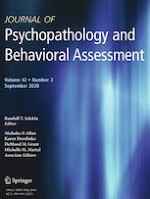07-01-2020
The Dualistic Role of Child Noncompliance: Normal Developmental Process and Indicator of Child Psychopathology
Gepubliceerd in: Journal of Psychopathology and Behavioral Assessment | Uitgave 3/2020
Log in om toegang te krijgenAbstract
Parent-collected home observations on Behavior Record Cards (BRCs) have yielded accurate and reliable frequencies of child noncompliance. In addition, prior cross-sectional clinic analog measurements have revealed dramatic improvement in child compliance probabilities after age 4.0 in normal children. The current project sought to extend the developmental transition in compliance probability to reductions in noncompliance frequency in the home. Four age groups (2-, 3-, 4-, and 5-year-old cohorts) of normal children participated. Parents were trained to detect and record noncompliance in the home for a two-week period on BRCs. Unlike the laboratory measurement of compliance probability, the transition point for reduced noncompliance frequency in the home for normal children was found to be age 5, rather than age 4, replicating prior observations of noncompliance frequency in the home. Several methodological differences may account for the inconsistent transition points, including sample size, coding accuracy, setting, and instruction quality. Since noncompliance is one symptom of Oppositional Defiance Disorder (DSM-5), data were transformed into daily occurrence percentages to determine if 5-year olds met the DSM-5 criterion of “at least once per week” and younger children met the DSM-5 criterion of “most days”. Virtually all these normal children (37 of 40) met DSM-5 criterion for symptomatic levels of noncompliance. Diagnostic implications are discussed and the lack of normative data based on observational measurements is lamented. It is recommended that both home noncompliance frequencies and clinic compliance probabilities be obtained to evaluate 2- to 6-year-old children referred for externalizing disorders.
